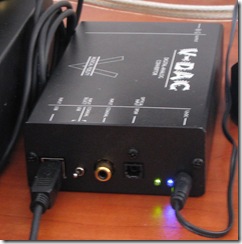 In the previous installment I have first experimented with rolling the tubes in my headphone amp, and first introduced an external DAC into one of my audio setups. Replacing the Electro Harmonix 6922EH tubes with a pair of matched JAN-Sylavnia 7308 tubes bought me a significant improvement in soundstage and resolution, and adding a Musical Fidelity V-DAC into the mix resulted in even better resolution at the expense of reduced imaging: In the previous installment I have first experimented with rolling the tubes in my headphone amp, and first introduced an external DAC into one of my audio setups. Replacing the Electro Harmonix 6922EH tubes with a pair of matched JAN-Sylavnia 7308 tubes bought me a significant improvement in soundstage and resolution, and adding a Musical Fidelity V-DAC into the mix resulted in even better resolution at the expense of reduced imaging:
“… the V-DAC features significantly improved accuracy and resolution, and more and more often I’ve been rewinding tracks just to make sure that, yes, I wasn’t imagining, I really have never heard this or that detail before… In fact, the only disadvantage is in a certain change in the soundstage, as though the stereo separation grew just a littler wider than I’d like. Don’t get me wrong, the soundstage is huge and imaging is terrific, but it sometimes seems to be that sounds tend to cluster a little closer to the extremes of the soundstage than they should.” When that upgrade was concluded I was left with an unfulfilled sense of curiosity. The first tube upgrade was a huge success, and the new DAC added the detail I was missing with the original setup, but I was not entirely happy with the difference in soundstage. Along with the 7308 tubes I bought a pair of Mullard E88CC; from what I’ve read on the tube I predicted that it would improve the soundstage, a theory which immediately I put to the test. 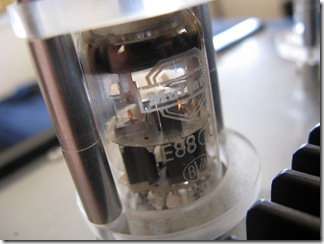
Great success! The 7308 tubes were such a huge step up, I did not expect to be so well-rewarded the second time around. The soundstage not only “deflated” to more natural-sounding positioning, but it also deepened (i.e. became more three-dimensional). Instrument articulation has improved dramatically: buzzing of metallic strings can be heard distinctly on decent recordings, bass has deepened remarkably and the sense of air around instruments can be absolutely mind-boggling. Even the noise floor dropped a few decibels. The improvement was so pronounced I now have a renewed desire to test additional tube amps, such as the Little Dot Mk IV SE or DarkVoice 336 SE. I’ll certainly post my experiences if I manage to get my hands on one of these… Finally content with my primary setup (which I primarily use at work), I have turned my attention to the secondary setup at home. At that point the setup consisted of an onboard ALC889A codec, connected to an Aqua Mini-Head via a generic analog interconnect, this in turn connected to ‘03 Beyerdynamic DT880 cans. In my previous post I had failed to mention that I did test the ‘05 edition DT880s with the 7308 tubes and found the new edition to be a downgrade: slightly better midbass marred by a muddy soundstage, flat treble (without the sense of “air” I’ve begun to associate with tube-based amplification) and a generally degraded experience than with the older edition. At that point I had almost put my original setup up for sale in its entirety, but decided to hold on to it for a few more experiments before I let it go. I took the opportunity to test those cans with the upgraded Mullard tubes, but am sad to report that no new synergy is to be found in that direction, and throwing the V-DAC into the mix did not result in any improvement either. 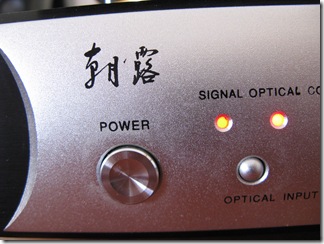 As it happens, an opportunity presented itself to buy an upgraded Zhaolu D2.5 DAC for a very good price, and after arranging to loan it for a few days I’ve had the chance to try out some interesting new combinations. The Zhaolu (apparently pronounced chow-loo) D2.5 is a modular DAC that, at a cost of $215, is widely considered as one of the finest and most customizable value-priced DACs on the market. There are a lot of aftermarket upgrades available for the device, and it’s offered with a headphone amplifier module for an extra $55. The device is based off of a CS4398 chip, and my particular unit comes with upgraded National LM4562 opamps. The unit is extremely large (24cm x 30cm x 5.5cm – about the same surface area as the G&W amp!) and surprisingly heavy. Build quality is fairly mediocre: the markings on the front tend to easily wear off and the volume control produces an audible distortion when adjusted. From a usability perspective the unit is decent but does have a couple of minor annoyances, specifically the need to select the optical channel every time I turn it on and an annoying blinking “mute” indicator when there is no active signal from the computer. As it happens, an opportunity presented itself to buy an upgraded Zhaolu D2.5 DAC for a very good price, and after arranging to loan it for a few days I’ve had the chance to try out some interesting new combinations. The Zhaolu (apparently pronounced chow-loo) D2.5 is a modular DAC that, at a cost of $215, is widely considered as one of the finest and most customizable value-priced DACs on the market. There are a lot of aftermarket upgrades available for the device, and it’s offered with a headphone amplifier module for an extra $55. The device is based off of a CS4398 chip, and my particular unit comes with upgraded National LM4562 opamps. The unit is extremely large (24cm x 30cm x 5.5cm – about the same surface area as the G&W amp!) and surprisingly heavy. Build quality is fairly mediocre: the markings on the front tend to easily wear off and the volume control produces an audible distortion when adjusted. From a usability perspective the unit is decent but does have a couple of minor annoyances, specifically the need to select the optical channel every time I turn it on and an annoying blinking “mute” indicator when there is no active signal from the computer.
The D2.5 has only S/PDIF and TOSLINK inputs, and I did not experiment with the V-DAC’s optical input to draw a comparison, so this is not a direct apples to apples comparison; that said, I connected the D2.5 to my desktop via TOSLINK, connected it via the preamp output to the G&W amp and started with the ‘03 edition Beyerdynamic DT880 headphones. The initial impression was severely disappointing: while the resolution was incredible, the sound had lost all warmth and the soundstage had lost all depth. Just to put things in perspective: this sounded significantly worse than with a straight analogue connection from my computer at work. I figured that since the integrated headphone amp in the D2.5 was designed along with the DAC the combination would probably work better; unfortunately, this resulted in an even flatter soundstage, and imaging suffered as well. 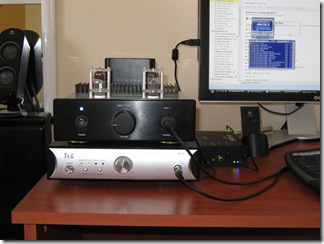 At this point I had almost given up on the DAC, but decided to switch back to the G&W amp and try out the ‘05 edition DT880s. This resulted in a markedly improved sound in comparison with the V-DAC and analogue connection; the sound gained some warmth, the soundstage expanded significantly and imaging improved as well. This is still a far cry from the ‘03 edition DT880 and V-DAC combination, but I could see how the Zhaolu DAC would benefit the cans if it was paired with the right amp. At this point I had almost given up on the DAC, but decided to switch back to the G&W amp and try out the ‘05 edition DT880s. This resulted in a markedly improved sound in comparison with the V-DAC and analogue connection; the sound gained some warmth, the soundstage expanded significantly and imaging improved as well. This is still a far cry from the ‘03 edition DT880 and V-DAC combination, but I could see how the Zhaolu DAC would benefit the cans if it was paired with the right amp.
While a definite improvement over the previous anemic combination, the results were still not satisfying. I briefly tried running the D2.5 and V-DAC through the Aqua amp but was not overly impressed; either the Mini-Head is not a good match for the DT880s (it was supposedly designed around the Sennheiser HD600) or it simply isn’t a very good amp. As an aside, in both cases the ‘03 edition sounded better to my ears than the ‘05. Having tried nearly every combination of equipment at my disposal I nearly gave up at this point, but for the sake of completeness decided to try out the D2.5 and its integrated headphone amp with the ‘05 DT880s. To my surprise, this combination is a winner: amazingly revealing, detailed sound combined with robust imaging and a wide (albeit not as deep as I’d like) soundstage. While not as musical as my primary system (G&W amp, Mullard tubes, V-DAC), the Zhaolu D2.5 provides better resolution and an experience that’s nearly as engaging as that combination for less than a fourth of the cost. Value for the money indeed! If you can find one of these units, I definitely suggest giving it a try; just make sure to test it first as it’s apparently quite finicky with regards to its partners. For my part, the Zhaolu D2.5 has permanently replaced the Aqua Mini-Head amp in my home setup; this, in turn, went to my brother who is quite pleased with it driving ‘03 DT880s via a Creative X-Fi sound card. Visit my Flickr account for more photos
Note: This is more or less a translation of two forum posts in an Israeli home theater website; if you can read Hebrew, you may be interested in the comments as well. First post, second post 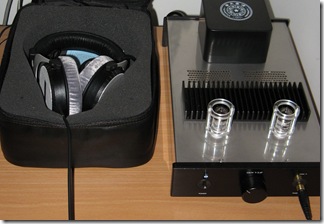 Lately I have been bit by the audio bug again, and have decided to experiment with my headphone setup. This is the setup I use at work and listen to for hours at a time (often 5 or more hours a day), and which consists of a pair of 2003 model Beyerdynamic DT880 cans I bought on a previous trip to China, hooked up to a G&W T-2.6F amp I bought on the same trip after having spent an hour listening to various equipment combinations. Unlike products from other, internationally recognized brands with which I am familiar (Creek, Musical Fidelity etc.) this product was completely out of my comfort zone: a Chinese-made amplifier, which like many others I normally associate with cheap components and subpar build quality. Additionally it is rather large and bulky, and to top it off, it is a hybrid design based on two Electro Harmonix 6922EH preamplifier tubes and a solid state power section. Up until that point I had heard solid state equipment exclusively, with the exception of two loudspeaker demonstrations in which the amplification included tube components and was significantly more expensive than I could even consider. Since I had not known what to expect I could not detect the subtleties of tube sound, and had chosen this headphone/amp combination strictly on being the best I had heard during that visit. Lately I have been bit by the audio bug again, and have decided to experiment with my headphone setup. This is the setup I use at work and listen to for hours at a time (often 5 or more hours a day), and which consists of a pair of 2003 model Beyerdynamic DT880 cans I bought on a previous trip to China, hooked up to a G&W T-2.6F amp I bought on the same trip after having spent an hour listening to various equipment combinations. Unlike products from other, internationally recognized brands with which I am familiar (Creek, Musical Fidelity etc.) this product was completely out of my comfort zone: a Chinese-made amplifier, which like many others I normally associate with cheap components and subpar build quality. Additionally it is rather large and bulky, and to top it off, it is a hybrid design based on two Electro Harmonix 6922EH preamplifier tubes and a solid state power section. Up until that point I had heard solid state equipment exclusively, with the exception of two loudspeaker demonstrations in which the amplification included tube components and was significantly more expensive than I could even consider. Since I had not known what to expect I could not detect the subtleties of tube sound, and had chosen this headphone/amp combination strictly on being the best I had heard during that visit.
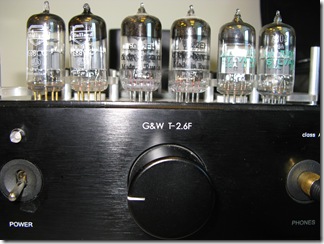 This setup was, in turn, hooked via a generic interconnect to my work computer with onboard HD audio, through which I play mostly lossless rips from my own CDs via Exact Audio Copy. It had faithfully served me for over three years, at which point I decided to do some research and was first exposed to the vast world of tube-based amplification and tube rolling. After several days of forum lurking and reading well into the night I had placed my first ever tube order at thetubestore.com. With the help of the shop representative, Jon, and general recommendations around the web, I had selected a matched pair of JAN-Sylvania 7308 tubes and yet another matched pair of Mullard E88CC tubes and placed my order. I did not have to wait very long, as the UPS delivery arrived amazingly fast (a single weekend, not too shabby for an international delivery!), and decided to spend a few weeks with each pair to be able to form an honest, educated opinion. I begun my experiments with what is, according to general consensus, the weaker tube: the JAN-Sylvania 7308. This setup was, in turn, hooked via a generic interconnect to my work computer with onboard HD audio, through which I play mostly lossless rips from my own CDs via Exact Audio Copy. It had faithfully served me for over three years, at which point I decided to do some research and was first exposed to the vast world of tube-based amplification and tube rolling. After several days of forum lurking and reading well into the night I had placed my first ever tube order at thetubestore.com. With the help of the shop representative, Jon, and general recommendations around the web, I had selected a matched pair of JAN-Sylvania 7308 tubes and yet another matched pair of Mullard E88CC tubes and placed my order. I did not have to wait very long, as the UPS delivery arrived amazingly fast (a single weekend, not too shabby for an international delivery!), and decided to spend a few weeks with each pair to be able to form an honest, educated opinion. I begun my experiments with what is, according to general consensus, the weaker tube: the JAN-Sylvania 7308.
What a shock! While I do not, for a moment, assert that similar or better sound cannot be found in solid state amplifiers, I certainly did not expect such a dramatic difference in sound quality. The soundstage, previously wide but shallow, simply exploded! It’s as though the sound instantly multiplied its volume tenfold or more; highs became wonderfully airy and distinct, and the resolution… let me put it this way: in every audio enthusiast’s life there are but few such moments of enlightenment, where you suddenly realize how much more is possible, and even attainable. The first time I’ve listened to the very same equipment with upgraded tubes provided me with one of those rare occasions, and from that point on I can never settle for less. 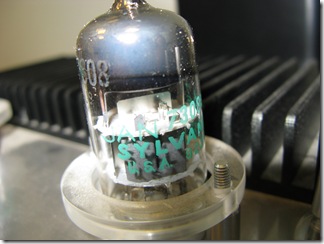 At the same time I had a second such revelation, albeit by accident: because of the physical layout of my desktop at work I was forced to place the amp further away from the computer, which necessitated a longer interconnect cable. I did not have one at hand and until I was done for the day I was left with no alternative but to use the iPod’s standard analog output. The iPod is generally considered to have very poor analog performance, which is why I was thoroughly surprised when, having brought a longer (and higher quality) interconnect from home and hooked the computer up, I found that the iPod actually sounded better. I recall when it was almost impossible to find a decent quality audio card for your computer, and assumed that contemporary solutions were at least adequate; indeed, the computer sound output was cleaner (better SNR) but also had significantly diminished dynamic range and volume. This led me to the conclusion that an audio card upgrade was in order. At the same time I had a second such revelation, albeit by accident: because of the physical layout of my desktop at work I was forced to place the amp further away from the computer, which necessitated a longer interconnect cable. I did not have one at hand and until I was done for the day I was left with no alternative but to use the iPod’s standard analog output. The iPod is generally considered to have very poor analog performance, which is why I was thoroughly surprised when, having brought a longer (and higher quality) interconnect from home and hooked the computer up, I found that the iPod actually sounded better. I recall when it was almost impossible to find a decent quality audio card for your computer, and assumed that contemporary solutions were at least adequate; indeed, the computer sound output was cleaner (better SNR) but also had significantly diminished dynamic range and volume. This led me to the conclusion that an audio card upgrade was in order.
A little research into the subject brought me to the the conclusion that what I’m interested in is not, in fact, a computer audio card; what I want is an external DAC, or more specifically a USB DAC. Getting a computer to output even half-decent analog audio is pretty much a futile quest, and while hooking it up via coaxial/optical S/PDIF would certainly work there are some significant disadvantages, namely: digital (lossy) volume control, and jitter. With S/PDIF, both clock and data signals are encoded together on a single data line, and the click has to be regenerated. This introduces subtle timing inaccuracies, generally known as jitter, which in have an undesirable impact on digital-to-analog conversion (a more scientific explanation can be found here). Just how significant an impact is a subject of much controversy, but at a USB DAC has the theoretical advantage of significantly reduced jitter on the protocol level, as well as removing the question of the onboard S/PDIF encoder’s clock accuracy from the equation. 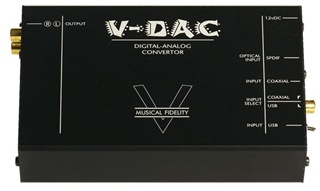 With the advice of fellow forum members I resolved to try one of the following DAC trio: Cambridge Audio DacMagic, Oritek OMZ DAC or Musical Fidelity V-DAC. Following a lead from a fellow forum member I eventually bought the V-DAC for a very good price from a head-fi.org forum member. The V-DAC is a 192KHz/24-bit upsampling DAC with optical, coaxial and USB inputs that has received high praise in the head-fi circles and is even available in Israel for a surprisingly reasonable price. With the advice of fellow forum members I resolved to try one of the following DAC trio: Cambridge Audio DacMagic, Oritek OMZ DAC or Musical Fidelity V-DAC. Following a lead from a fellow forum member I eventually bought the V-DAC for a very good price from a head-fi.org forum member. The V-DAC is a 192KHz/24-bit upsampling DAC with optical, coaxial and USB inputs that has received high praise in the head-fi circles and is even available in Israel for a surprisingly reasonable price.
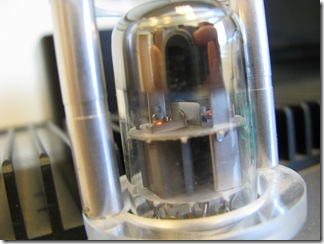 I hooked the unit up with an unnamed but high quality silver interconnect, and after significant critical listening I can draw the following conclusions: compared with both iPod and onboard audio card (as well as an old Audigy 4 I had lying around) the V-DAC features significantly improved accuracy and resolution, and more and more often I’ve been rewinding tracks just to make sure that, yes, I wasn’t imagining, I really have never heard this or that detail before. This is exactly what I got into audio for in the first place! The bass is also much tighter, and in my opinion also extends further down than it ever did. In fact, the only disadvantage is in a certain change in the soundstage, as though the stereo separation grew just a littler wider than I’d like. Don’t get me wrong, the soundstage is huge and imaging is terrific, but it sometimes seems to be that sounds tend to cluster a little closer to the extremes of the soundstage than they should. I hooked the unit up with an unnamed but high quality silver interconnect, and after significant critical listening I can draw the following conclusions: compared with both iPod and onboard audio card (as well as an old Audigy 4 I had lying around) the V-DAC features significantly improved accuracy and resolution, and more and more often I’ve been rewinding tracks just to make sure that, yes, I wasn’t imagining, I really have never heard this or that detail before. This is exactly what I got into audio for in the first place! The bass is also much tighter, and in my opinion also extends further down than it ever did. In fact, the only disadvantage is in a certain change in the soundstage, as though the stereo separation grew just a littler wider than I’d like. Don’t get me wrong, the soundstage is huge and imaging is terrific, but it sometimes seems to be that sounds tend to cluster a little closer to the extremes of the soundstage than they should.
All in all I’m extremely happy with the upgrade, and luckily I still have some new equipment left to play with: the Mullard E88CC tubes, patiently awaiting my pleasure. Still, now that there’s such a significant difference in fidelity between my work and home setup (which consists of an Aqua Mini-Head amp and Beyerdynamic DT880 2005 edition cans) I feel compelled to experiment with new equipment. Whatever shall I try next, a new DAC? Another amp? Different cans, perhaps? The choices are endless, and that’s the beauty of it. See you on the next upgrade. Update: Some more pictures can be found here.
This guy hooked up an old Sinclair ZX Spectrum to a bunch of crappy hardware (a hard drive array, an old dot matrix printer and a scanner) and got them to play an amusing (though still impressive) approximation of Radio Head's "Nude". Here's to a bigger geek than I can ever hope to be! 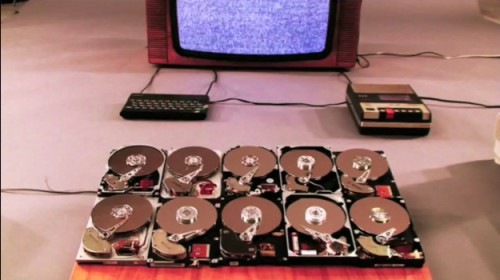
Long time no update. Reason? A vacation in Europe - mostly centered around the Netherlands (which I like very much). In the meantime I'll just post some random musings: - Radiohead rock. I have this thing where, when I hear music that I immediately dislike or "don't get," I feel obliged to give it another go every year or so. It took my years to learn to like Pink Floyd, and even more time to learn to like Radiohead, but after a serious listening session I have to concede that my friend (who we shall term "the rhesus") was right to call OK Computer "one of the 20th century's sublime records."
- At Outline 2007 (on which I will expand in a seperate post) I got acquainted with a Dutch tracker who styles himself Cosmiq. Take a listen to his second album, which I actually really liked (particularly track 3, "A Shine Too Much").
- You'll notice that I added a button for the FSF's latest campaign, Play OGG, under "advocacy" on the right. I'll take OGG over MP3 any day (on account of better sound quality for size, and no licensing fees for anyone); I don't expect the campaign to be wildly successful, but you never know. Maybe I'll actually be able to enjoy my next iPod or car audio set on my own terms.
- Had a bit of time to spare, so I watched The Karate Kid again. The movie certainly looks different after 10 or so years -- it actually looks better (if you discount the obligatory '80s movie influences). Pat Morita is extremely funny, and I've seen much worse actors than Ralph Macchio (who looks much younger than his 23 years at the time). It also happens to be a really quotable movie, mock Eastern wisdom notwithstanding: "to make honey, young bee need young flower, not old prune."
Next on the agenda: Spiderman 3.
I got a heapload of new music from a friend (thanks, Gil!) and wanted to share a couple of recommendations: - The Flower Kings - a Swedish progresive rock band. I actually made the mistake of thinking them an American band (something about the style struck me as US-oriented), but regardless they really are very good at what they do. I've given serious listening time to Unfold the Future and it's straight at the top of my to-buy list.
- KBB - a relatively anonymous Japanese progressive band. Their first album "Lost and Found" (1999) is positively brilliant. I hope to catch one of their concerts at some point in Tokyo, but the site is completely out of date.
If anyone's interested in progressive rock and/or has recommendations to add, I'd be delighted to hear (just send me an e-mail or drop a comment).
No idea where I found the link (but someone definitely deserves credit for that), but you gotta see this music video for Don't Download This Song, from Weird Al's new album "Straight Outta Lynwood."
Around 21:00, June 22nd 2006, Neve
Shalom.
Roger Waters appears on stage for the first time in Israel.
This is the biggest thing to happen here all year, and one of the most
important events in my life. I'm still finding it a little difficult to find the
right words... and as they say, a picture is a lot more economic, so:

Image by Assaf Carmeli. Click
here for more
pictures
54,000 people singing in unison the lyrics for some of the best known rock
songs in history. It was a three-hour aureal orgasm.
I want to go back.
So I'm sitting at work, listening as I usually do to all sorts of music in
the background. I found myself listening to the excellent soundtrack written for
A Clockwork
Orange (which also happens to be one of the best movies I've ever
seen). Some of the classical pieces there have a distinct ring to them,
as if they've been performed in a very peculiar and distinct (somewhat
synth-y, for lack of a better word) style. It kept bugging me that I've
heard this someplace before, and after some 40 minutes it finally struck me: it
sounds highly similar to the soundtrack written for the movie Tron (also highly
recommended).
I took a better look at the tracks to see who wrote them - a Walter Carlos.
This was even more surprising for me, because I recall the Tron soundtrack
credited to a Wendy Carlos. What's up?
Some digging in
wikipedia proved once again extremely fruitful:
Her first six recordings were released under the name Walter Carlos,
although, being a transsexual woman, she had already changed her name from
Walter to Wendy. In 1972, Carlos underwent gender reassignment therapy. The
last release to be credited to Walter Carlos was By Request (1975). The first
release as Wendy was Switched-On Brandenburgs (1979). Carlos's first public
appearance after her gender transition was in an interview in the May 1979
issue of Playboy magazine, a decision she would come to regret as it brought
unwelcome publicity to her personal life. On her official site, her transition is
discussed in an essay stating that she values her privacy on the
subject.
The universe never ceases to surprise me.
I'm a self-proclaimed part-time, low-budget audiophile (there's a
mouthful), so I often try to combine good performance with reasonable cost. To
that end, considering I spend about 80% of my time at work (and, up until
recently, home as well) with headphones on my head, the Sennheiser
HD600s I got about five years ago for the price of about 200 of today's US
dollars after shipping and taxes were the absolute best bargain I've
ever made. The Jean-Marie Reynaud Twin
MK2 speakers I also bought at about the same time were so impressive that
the lowest-priced comparable speakers were 60% more expensive.
Things have somewhat improved since then; the taxes on audio equipment in
Israel have been considerably reduced, although at some 34% they're still very
high (down from 70%...). I mentioned this before in my post regarding the Yakumo Hypersound Car. Since
then I went to an auto shop for some additional equipment, specifically a 6x9"
component set, 3.5" mids to replace the crappy ones in my Punto, a 12" Pioneer
sub and 2x60w (continuous) amp (I'll post the models number later - damned if I
remember).
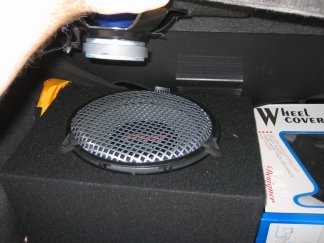 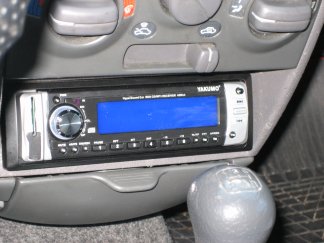 On
the left: Pioneer sub under the component speak, on the right: Yakumo Hypersound
Car installed While the CD receiver was a breeze to install, I'm pretty glad I didn't
attempt to do the rest of it alone; I don't know jack about car electronics and
some of the stuff involving the installation of the amp I didn't know to begin
with (such as hooking up the negative terminal to the car chassis) and I
would've done a heck of nasty job if I tried running some of the wires on my
own. On the other hand, contrary to my usual cautious self I didn't do much
market research and ended up paying considerably more than the equipment
was worth. It was definitely a learning experience, though, and I won't make
these mistakes next time.
That said, the sound is great - not perfect but I'm still tweaking it. The
Yakumo unit turns out to have very poor amplification; at first I thought the
specified 65dB signal-to-noise
ratio was a mistype in the product manual, but it turns out rather accurate;
there is a very audible hiss at even moderate volume levels (which I couldn't
hear earlier because of the crappy speakers I bought the car with) and the
rear-speaker sound is bright to the point of being harsh. This may or may not be
attributed to the Pioneer component speakers - if so you can bet that they'll be
replaced - but in the meanwhile I've found the amplification so horrid that I'm
replacing the 2-channel monobridged Pioneer amp with a quad-channel amp to drive
both sub and rear speakers (5- and 6-channel amplifiers are prohibitively
expensive, so I'll skip those for now).
The Yakumo unit also suffers from some pretty severe usability issues; the
TOC indexing times for USB devices (tested with a fully loaded iRiver
H320) were nothing short of abhorring (about 3 minutes from iRiver boot).
With CDs the problem is less of an issue, about 20 seconds for a 700MB CD, but I
still think it's rather stupid that the unit can boot up to the exact location I
last powered it off in but has to index the TOC first. The random mode is
extremely useful with compressed files, but why does it change track when I turn
it on? The fact that I can't navigate by folder (particularly with the existence
of a jog dial!) without going through the tedious search function is
ridiculous, and I've actually managed to get the unit's firmware to crash once
or twice (Update: actually, the unit seems to be extremely crash-prone). I believe most if not all of these problems can be solved with a
little work on the drive's firmware, but there is none from Yakumo. In my
opinion the solution would be to simply open-source the firmware; it's
probably based mostly on LGPL'd code to begin with,
and it would allow community involvement in empowering the brand. I, for one,
would be delighted to tweak the source code to my heart's content; it would make
the unit all that more useful. With the lackluster amplification and usability
issues it's very hard to recommend the unit to anyone but a die-hard OGG Vorbis fan. Update: Having owned this unit for several months I can safely say that it, quite plainly, sucks. It is crash-prone, error-prone, extremely slow on boot up, requires constant resets and provides very low sound quality to boot. Its one saving grace is Vorbis support, and even for me that's not enough to save it from a "piece of crap" verdict. I'm going to replace this thing as soon as I find a decent alternative; the XiphWiki points at a similar product from Silvercrest, but given the track record of these things I'm inclined to forego in-dash players altogether and go for a hard-drive based solution. Now if I can only find a decent one...
I can hardly contain my excitement, so I just won't bother. Suffice to say that Aural Planet have made their excellent album Lightflow freely downloadable! If you're into ambient, electronic and/or deep trance music give this a listen. Even if not, at least spend a couple of minutes listening to Pipe Life (track 2) - you might be surprised.
I bought the album back in 2001, and now you can get this excellent music for free. What more could you wish for?
On a completely seperate note, check out the Demovibes collections - excellent demo music fully compiled for your streaming pleasure.
Lev (my friend from Eilat) hopped back north for a visit, which was perfect timing to go to the Hot Fur CD release concert in the Koltura club in Tel-Aviv. And let me tell you, it was the absolute bomb!
We arrived a little early (the show was supposed to start at 22:00 with the doors open at 21:00), the place was still nearly deserted and a Frank Zappa concert played in the background. We went out to grab a bite to eat, and when we came back people were starting to pile up. I don't really have much of an idea how many people were present when the show actually started (half an hour late...) but it was probably 150-200 as the place is supposed to be able to hold 400 people and it wasn't horribly packed.
Audience at large (you can thank Ilya Konstantinov for the pictures)
Hot Fur started by playing their new music video for "Adventure In Space", which was hilarious and got everyone riled up and ready for the concert; they immediately proceeded with "The Letter Vav" and over the next 1.75 hours proceeded to play most of their bread-and-butter repertoiré, including (but not limited) to "Sabres 15003", "I Won't Give Up" and (I think) "Tomatoes". Now what's really great about Hot Fur concerts is that they do not only make and play great music, but they also know how to put on a great show:
Between (and often during) musical segments guys related to the band would put on bizarre costumes and indulge in what must be the greatest fun the world: acting really stupid in front of hundreds of people who appreciate stupidity. I particularly liked this character (the main character in the "Adventures In Space" video), who for lack of a better name I like to call The Dude:
The Dude makes many appearances during the show...
... like this one
Among diverse distractions the band kept throwing roses at the audience, and I finally found myself looking thus:
Roses are red, violets are blue...
And eventually broke down altogether:
... I love Hot Fur, and so should you
At the end of the show, we finally managed to get our hands on our preordered Hot Fur CDs (which we've been eagerly awaiting for for the past year). Besides the great music us preorderers were delighted to find our names in the "thank you" section of the CD...
Hot Fur'll be appearing in Koltura again on July 27th (I think). Don't miss it.
Eric Lippert
has an incredibly interesting five-part blogpost about the mathematical
essence of musical theory, along with some pretty nifty demonstrations.
I've dabbled a little in the more practical applications of musical
theory before (writing wave and module players and some basic software
synths) but honestly have never been really interested in its
mathematical/physical aspects.
This, ladies and gentleman, is interesting shit.
Paniq came out with a new album a couple of weeks ago, the second track from which is called Elektronische Musik (can be downloaded from here). It's in German though, so make sure you read the lyrics.
|